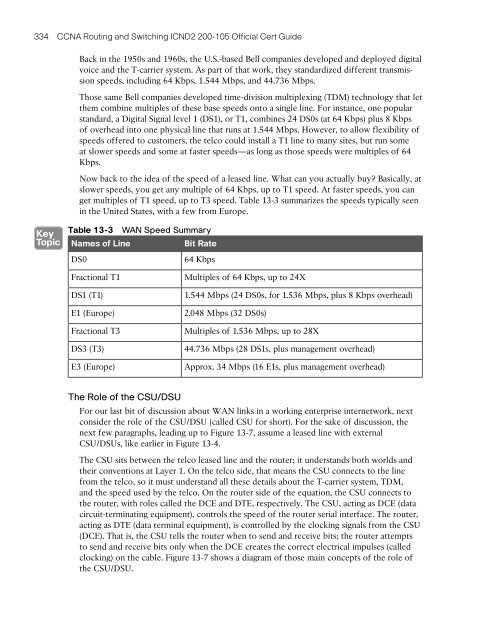CCNA Routing and Switching
HuPe306583u
HuPe306583u
Create successful ePaper yourself
Turn your PDF publications into a flip-book with our unique Google optimized e-Paper software.
334 <strong>CCNA</strong> <strong>Routing</strong> <strong>and</strong> <strong>Switching</strong> ICND2 200-105 Official Cert Guide<br />
Back in the 1950s <strong>and</strong> 1960s, the U.S.-based Bell companies developed <strong>and</strong> deployed digital<br />
voice <strong>and</strong> the T-carrier system. As part of that work, they st<strong>and</strong>ardized different transmission<br />
speeds, including 64 Kbps, 1.544 Mbps, <strong>and</strong> 44.736 Mbps.<br />
Those same Bell companies developed time-division multiplexing (TDM) technology that let<br />
them combine multiples of these base speeds onto a single line. For instance, one popular<br />
st<strong>and</strong>ard, a Digital Signal level 1 (DS1), or T1, combines 24 DS0s (at 64 Kbps) plus 8 Kbps<br />
of overhead into one physical line that runs at 1.544 Mbps. However, to allow flexibility of<br />
speeds offered to customers, the telco could install a T1 line to many sites, but run some<br />
at slower speeds <strong>and</strong> some at faster speeds—as long as those speeds were multiples of 64<br />
Kbps.<br />
Now back to the idea of the speed of a leased line. What can you actually buy? Basically, at<br />
slower speeds, you get any multiple of 64 Kbps, up to T1 speed. At faster speeds, you can<br />
get multiples of T1 speed, up to T3 speed. Table 13-3 summarizes the speeds typically seen<br />
in the United States, with a few from Europe.<br />
Table 13-3 WAN Speed Summary<br />
Names of Line<br />
Bit Rate<br />
DS0<br />
64 Kbps<br />
Fractional T1<br />
DS1 (T1)<br />
E1 (Europe)<br />
Fractional T3<br />
DS3 (T3)<br />
E3 (Europe)<br />
Multiples of 64 Kbps, up to 24X<br />
1.544 Mbps (24 DS0s, for 1.536 Mbps, plus 8 Kbps overhead)<br />
2.048 Mbps (32 DS0s)<br />
Multiples of 1.536 Mbps, up to 28X<br />
44.736 Mbps (28 DS1s, plus management overhead)<br />
Approx. 34 Mbps (16 E1s, plus management overhead)<br />
The Role of the CSU/DSU<br />
For our last bit of discussion about WAN links in a working enterprise internetwork, next<br />
consider the role of the CSU/DSU (called CSU for short). For the sake of discussion, the<br />
next few paragraphs, leading up to Figure 13-7, assume a leased line with external<br />
CSU/DSUs, like earlier in Figure 13-4.<br />
The CSU sits between the telco leased line <strong>and</strong> the router; it underst<strong>and</strong>s both worlds <strong>and</strong><br />
their conventions at Layer 1. On the telco side, that means the CSU connects to the line<br />
from the telco, so it must underst<strong>and</strong> all these details about the T-carrier system, TDM,<br />
<strong>and</strong> the speed used by the telco. On the router side of the equation, the CSU connects to<br />
the router, with roles called the DCE <strong>and</strong> DTE, respectively. The CSU, acting as DCE (data<br />
circuit-terminating equipment), controls the speed of the router serial interface. The router,<br />
acting as DTE (data terminal equipment), is controlled by the clocking signals from the CSU<br />
(DCE). That is, the CSU tells the router when to send <strong>and</strong> receive bits; the router attempts<br />
to send <strong>and</strong> receive bits only when the DCE creates the correct electrical impulses (called<br />
clocking) on the cable. Figure 13-7 shows a diagram of those main concepts of the role of<br />
the CSU/DSU.


